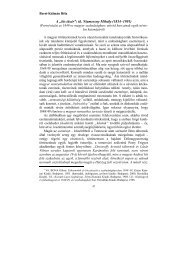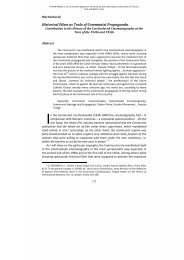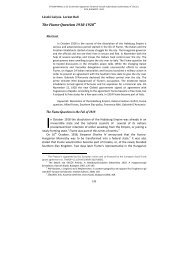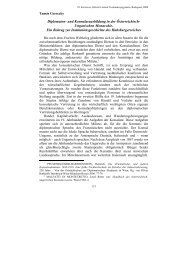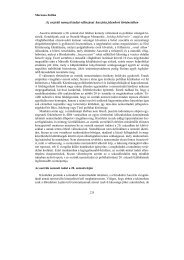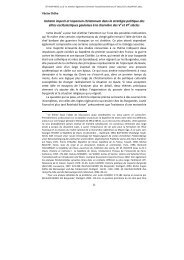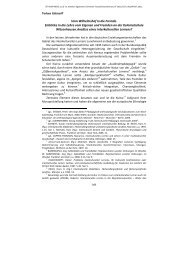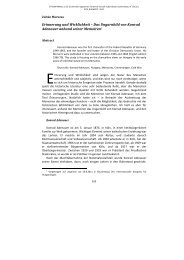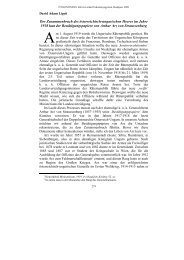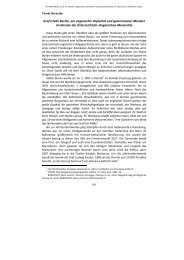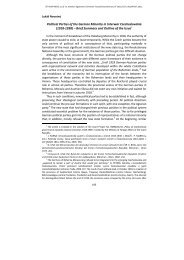The Molotov-Ribbentrop Pact - ELTE BTK Történelem Szakos Portál
The Molotov-Ribbentrop Pact - ELTE BTK Történelem Szakos Portál
The Molotov-Ribbentrop Pact - ELTE BTK Történelem Szakos Portál
You also want an ePaper? Increase the reach of your titles
YUMPU automatically turns print PDFs into web optimized ePapers that Google loves.
Although in 1933 Little Entente institutionalised itself, there were lack of real<br />
cooperation and common goals, instead of protection against Hungarian<br />
revisionism. <strong>The</strong> main problems of the Little Entente was the territorial<br />
incoherence, border problems between Romania and Yugoslavia and rising<br />
pressure from three different powers: Germany on Czechoslovakia, Soviet<br />
Union on Romania and Italy on Yugoslavia. 4<br />
An important country in Central Europe was definitely Poland, because of<br />
its size, geopolitical localisation between Germany and Soviet Union,<br />
economical and political impact on the other countries of the region. According<br />
to this and above-mentioned good relations Romania tried to win Poland over<br />
to a cause of antirevisionism and Little Entente. It did not come to realise<br />
because of well-grounded relations between Poland and Hungary. 5 <strong>The</strong> other<br />
reason is that Poland did not want to be engaged into regional cooperation<br />
project which was in fact very weak. Politicians from Poland had different<br />
projects, in which they would be able to establish the position of their country<br />
as the regional power and appear as one of the most significant European<br />
countries. Main project called Intermarium was pursued by Józef Piłsudski. He<br />
was willing to create a federation of central and eastern European nations as a<br />
counterweight to the Germany on west and Soviet Union on east. <strong>The</strong><br />
federation leaded by Poland was to contain also: Finland, Estonia, Latvia,<br />
Lithuania, Belarus, Ukraine, Czechoslovakia, Hungary, Romania and<br />
Yugoslavia. <strong>The</strong> project failed due to annexation of Belarus and Ukraine to the<br />
Soviet Union. Even though there was still and idea of federation in the narrow<br />
scope, but it was also denied by the bilateral conflicts which I mentioned at the<br />
beginning. This idea was later followed by Władysław Sikorski, who put<br />
forward the project of Central European Union and Józef Beck with his 'Third<br />
Europe' conception, but in fact both were far from realization. 6<br />
Due to the failure of an organisation connecting all Central European<br />
countries, each of them concentrated on developing bilateral relations in the<br />
region and out of it. Poland after establishing its borders in the years 1918 - 1921<br />
developed foreign policy. First international alliance treaties were signed with<br />
France in February 1921 and in the next month with Romania. I am going to<br />
present the alliance with France in detail later. Concerning alliance with Romania<br />
the treaty from March 1921 was mainly aimed against possible military action<br />
from the side of Russia. 7 This bilateral cooperation developed through the whole<br />
4<br />
Ibidem. 245-250, 266-280.<br />
5<br />
WILLAUME, Małgorzata: Rumunia. Trio, Warsaw, 2004. 127.<br />
6<br />
KORNAT, Marek: Realna koncepcja czy wizja ex post? Polska idea „Trzeciej Europy”<br />
(1937-1938). <strong>The</strong> website of Wyższa Szkoła Biznesu – National Louis University,<br />
http://politologia.wsb-nlu.edu.pl/uploadedFiles/file/M_Kornat - Realna koncepcja czy wizja ex<br />
post.pdf (date of usage: 20 March 2010).<br />
7<br />
DEMEL, Juliusz: Historia Rumunii. Zakład Narodowy im. Ossolińskich, Wrocław, Warsaw,<br />
Cracow, Danzig, Łódź, 1986. 387.<br />
52



